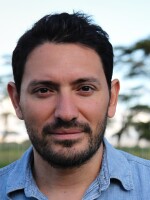The American businessman who paid $20 million to visit the International Space Station in 2001, has presented an ambitious plan for a manned fly-by mission to Mars.
If all goes as planned, a couple would be on a rocket headed to the Red Planet in January of 2018.
that Dennis Tito has created a non-profit organization called Inspiration Mars Foundation that will raise the funds for the mission through donations.
The space news site, reports that, today, the organization by a group of experts including NASA scientists that finds the mission is feasible with current technology.
Here's how Space Ref says the mission will work:
"The core premise of this initial mission concept is to use an upgraded SpaceX Dragon capsule as the habitable volume for the entire mission. This spacecraft would be launched on a SpaceX Falcon Heavy and follows an optimized free-return trajectory to Mars and back. As outlined in the paper, this conceptual mission would depart Earth on 5 Jan 2018, reach Mars on 20 August 2018, and return to Earth on 21 May 2019.
"The closest that the spacecraft would get to Mars would be 100,000 km - and the crew would only spend 10 hours within that distance of the planet - with closest approach on the night side. Not too different than the first human mission to the Moon when all things are taken into account
"Upon return, the Dragon capsule would use Earth's atmosphere to slow down via aerobraking. This has never been done with a human mission before. Ten days after aerobraking the Dragon capsule would return again to Earth and reenter at 14.2 km/sec. This would be the fastest reentry by any crewed spacecraft - ever. As such, this mission will require some advanced Thermal Protection System research. To that end Paragon/Inspiration Mars have already signed a reimbursable Space Act Agreement with NASA Ames Research Center. A check for $100,000 has already been presented to NASA to begin this work."
that mission planners are looking for an older couple who could survive the very challenging — and incredibly cramped — conditions of the year-and-a-half long trip.
"The plan was to choose a middle-aged couple because their health and fertility would be less affected by the radiation they would be exposed to during such a long space mission," the BBC reports.
that Tito is not planning on going on the mission himself.
The site asked Tito if this was a science mission.
"At first, I thought this is not a science mission," Tito said. "This is for inspiration; it's a test flight to show we can get there. You're going to learn a lot about the engineering problems. But then as I started learning more about the life sciences, apparently [the benefits] are huge. There hasn't been really any information on human behavior in this kind of environment. The impact of radiation, the isolation — the academics are all very excited. It'd be a huge scientific value in the life sciences."
Tito said he gives the mission a "good chance" of taking off in 2018.
Copyright 2020 NPR. To see more, visit https://www.npr.org. 9(MDAxNDQ2NDAxMDEyNzU2NzM2ODA3ZGI1ZA001))








